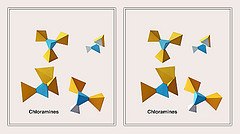 For many years, chlorine was the disinfectant that was most commonly used by water treatment plants to treat drinking water supplies. Chlorine is extremely effective at killing dangerous pathogens and other contaminants that could otherwise cause waterborne illnesses. But in recent years, many cities have been switching to chloramine as their primary disinfectant. And like chlorine, chloramine produces chemical byproducts in water that can be dangerous to your health. Today we’re going to talk about what chloramine is, why it’s being used by water treatment plants, the health effects it can cause and what you can do to remove it from your water!
For many years, chlorine was the disinfectant that was most commonly used by water treatment plants to treat drinking water supplies. Chlorine is extremely effective at killing dangerous pathogens and other contaminants that could otherwise cause waterborne illnesses. But in recent years, many cities have been switching to chloramine as their primary disinfectant. And like chlorine, chloramine produces chemical byproducts in water that can be dangerous to your health. Today we’re going to talk about what chloramine is, why it’s being used by water treatment plants, the health effects it can cause and what you can do to remove it from your water!
What is chloramine?
Chloramine is a mixture of chlorine and ammonia. Because it contains chlorine, chloramine has similar disinfecting properties as chlorine on its own. The difference is that chlorine is more powerful of a disinfectant, but it does not last as long as chloramine. Chloramine, on the other hand, is less powerful but remains effective for a longer time than chlorine.
Why are water treatment plants switching to chloramine?
Chloramine has actually been used by water treatment plants for quite some time as a secondary disinfectant, primarily because of its ability to last longer than chlorine. But in recent years, water treatment plants have been switching to chloramine as their primary disinfectant for the following reasons:
- It’s less expensive than chlorine, so it costs less for the city to treat water.
- It’s less detectible by the human senses, so tap water doesn’t have as much of a chlorine taste or smell.
- It lasts longer than chlorine, which allows it to keep disinfecting water as it travels through the city’s pipes and into homes.
- It produces a smaller amount of THM’s, which are the dangerous contaminants that chlorine produces when it interacts with organic matter in water.
Why should you consider removing chloramine from your water?
Even though chloramine produces better tasting water with fewer THM’s, it still comes with its own set of quality issues. The first of those being that THM’s are still produced in water that contains chloramine, just at a smaller level. Even at low doses, THM’s can cause health problems after long-term exposure such as respiratory problems, a weakened immune system and cardiovascular issues.
In addition, chloramine actually produces its own kind of chemical byproducts that are not found in chlorine on its own. Many of these byproducts have not been thoroughly studied, which is a problem on its own, but some people believe they can be 1,000 times more toxic than THM’s.
One final issue with chloramine is that it’s more corrosive than chlorine. This can cause your pipes to corrode after long-term exposure, which can allow heavy metals like copper and lead to leech into your water.
How can you remove chloramine from your water?
Luckily, chloramine can easily be removed by many water filtration systems. Carbon filters are particularly effective at removing chloramine, and reverse osmosis systems are very effective as well. Regardless of the type of system you choose to install, we suggest that you go with a whole-house system to remove chloramine in order to avoid damage to your home’s pipes and to prevent you and your family from breathing in the chemical’s byproducts in the shower.
If you have any questions about removing chloramine from water, or if you’d like a water system serviced or installed in your home, contact EPA Water, your water softener and water filtration system dealer in Pennsylvania and New Jersey. We provide service all over Eastern Pennsylvania and New Jersey, including towns like Newtown, Buckingham and Lansdale, PA.
photo credit: jacobs_ian via photopin (license)
